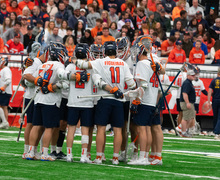Women, equality and the Syracuse University Marching Band
David Salanitri | Staff Photographer
Women have been allowed to participate in the Syracuse University Marching Band for only about 50 years.
Editor’s note: In light of Women’s History Month, this four-part series looks into how Syracuse women have contributed to the fight for equality.
Linda Meltzer Strickon chose to attend Syracuse University knowing she wanted to be a band conductor. But it wasn’t until she got to campus in September 1964 that she discovered there were no women in the Syracuse University Marching Band.
“I was upset because I loved marching band, and I was in it in high school,” said Strickon, who graduated in 1968 with a degree in music education. “Why didn’t I look into that before?”
Strickon had to wait until her junior year when university policies finally allowed women to join the marching band, which she said at the time was composed of around 100 members. Before that, women could only play in concert bands in orchestras.
Courtesy of SU Archives
She was one of the first 22 women to play in the marching band in 1966, marking a step away the name “100 Men and a Girl” — a moniker used to describe the band that formerly consisted of all men and one baton twirler.
Fifty years later in 2016, 104 out of the 175 members of the SU marching band are female. They play across all sections of the band, including saxophones, flutes and trumpets. This year, three women serve as drum majors, leading the band on and off the field.
It just shows that somehow more and more women are becoming interested in music. It shows that they do pick based on who is best.Linda Meltzer Strickon
• • •
Twenty-three men helped create SU’s first official band in 1901, relying on donations, concert proceeds and community support.
Though 1966 was the first year women became permanent members of the marching band, there was a time when women were allowed to temporarily march with the group. During World War II, the shortage of men forced the university to recruit women who had been in band in high school or had enough musical knowledge to keep up.
The women made their debut in October 1943 during a football game between Colgate and Cornell universities.
But this opportunity was short-lived. There were some talks of creating an all-female marching band after the war, but when veterans returned and a new director took over in 1947, the band went back to being all males.
The change in 1966 was largely due to Edward W. Volz, the band director at the time who, in interviews, said he could “build a better case for putting women in than keeping them out.”
Courtesy of SU Archives
Devil’s advocates at the time posed many questions: Are girls able to take the physical strain of marching? Will they object to getting their hairdos wet? Could they march in the mud and still carry their weight musically?
“Since a girl normally takes shorter steps and is not as tall as a boy, we have found it is not advisable to put a short girl on the outer step of a pinwheel formation,” Volz said in a 1966 interview with The Syracuse Herald-Journal. “In every other respect, she’s fine. Women have proven reliable, have helped to fill and expand the band, and have added an element that has changed the character of the band, settled it down.”
During Strickon’s first two years at SU, she would go into the offices of the band conductor and the dean of the school of music to let them know she wanted to be in the band.
Their response was usually the same: “We’ll think about it.”
When the school finally made an announcement about letting women in during her junior year, Strickon said she immediately signed up and was allowed to play.
Strickon didn’t play the band during her senior year because she studied abroad in Florence, Italy, during the fall semester. But she said she’s glad she was able to make great memories with the band, including traveling to Jacksonville, Florida, with the SU football team to perform in the Gator Bowl, and performing during a halftime show with Doc Severinsen, bandleader of “The Tonight Show with Johnny Carson.”
“Everything was so exciting, and these were opportunities I would not have had if I had not been in the marching band,” Strickon said.
• • •
Since Fall 2014, Ashley Ogasawara was a section leader for the marching band’s flute section. The senior computer art and animation major called it being the “mom” of the section, putting together bonding events and teaching new members how to march.
Ogasawara is one of 38 section leaders this year, 23 of which are women. She said she wanted to become a section leader to make sure that incoming band members were welcomed into a cohesive and safe environment where everyone was included.
Courtesy of SU Archives
“We made it clear that we cared about everyone, even outside of practice time. We made sure we would include the rookies, and it’s just gotten better and more open,” she said.
This is the kind of environment that marching band director Justin Mertz expects members of the band will create for each other: open and inclusive, where “everyone is safe to be who they are.”
As leaders in the band, students gain real-life experience, Mertz added. They’re “empowered and expected” to practice conflict resolution and implement solutions to problems they come across.
He also said the students’ success in their roles isn’t due to whether they are men or women — it’s because they have the qualities that talented and smart leaders exhibit.
“I think the evolution of the role of women in the marching band has mirrored the evolution of the role of women on campus and in society at large,” Mertz said. “As social progress happened and women stepped into roles that were previously viewed as exclusively for men, it’s only natural that the representation in the SUMB and SU would increase.”
• • •
Every year, three students in SUMB are chosen to be drum majors. They’re the most visible leaders of the band, conducting at games, leading practices and planning events.
During Mertz’s first year as director of the SUMB, all three drum majors were female. One was alumna Jen Luzzo, who received her undergraduate and graduate degrees from SU in 2007 and 2009, respectively.
Courtesy of SU Archives
Luzzo held the position of drum major during her junior and senior year. She returned the next two years as a graduate assistant while studying for her master’s in music education.
“Being two steps ahead of everyone else and trying to think forward was a skill you needed to learn as drum major, and that’s something that I still use today,” Luzzo said.
For Luzzo, the position of drum major is not a gendered role. She said she’s proud of the individuals — the students who stand before the almost 200-person ensemble and conduct during football games in the Carrier Dome.
Just like 10 years ago when Luzzo held the position, three women now serve as the band’s drum majors. Mackenzie Mildram, a junior music education major, said she and the other drum majors embrace the fact that they’re women.
Each year, Mildram said the drum majors choose the lanyards they wear around their neck for their whistles. Their only requirement is that it has to be the color orange and have something SU-related on it. This year, they chose bejeweled orange lanyards that have the Syracuse “S” on them.
There was something really powerful about having the drum majors be three women. We owned it.Mackenzie Mildram
After her freshman year, Mildram applied to be drum major because she wanted to contribute more to the band. Though she didn’t get the position right away, she applied again during her sophomore year while she was studying abroad in Strasbourg, France.
Looking back at the history of women in the marching band, Mildram said she couldn’t believe that it has only been 50 years since women were first given the opportunity to play.
“For me, there was never a question whether or not my gender would impact my experience in SUMB,” Mildram said. “I feel very fortunate for that, for not having to be worried about these sorts of things. It’s never felt exclusive at all.”
Published on March 6, 2016 at 11:16 pm
Contact Clare: [email protected]








